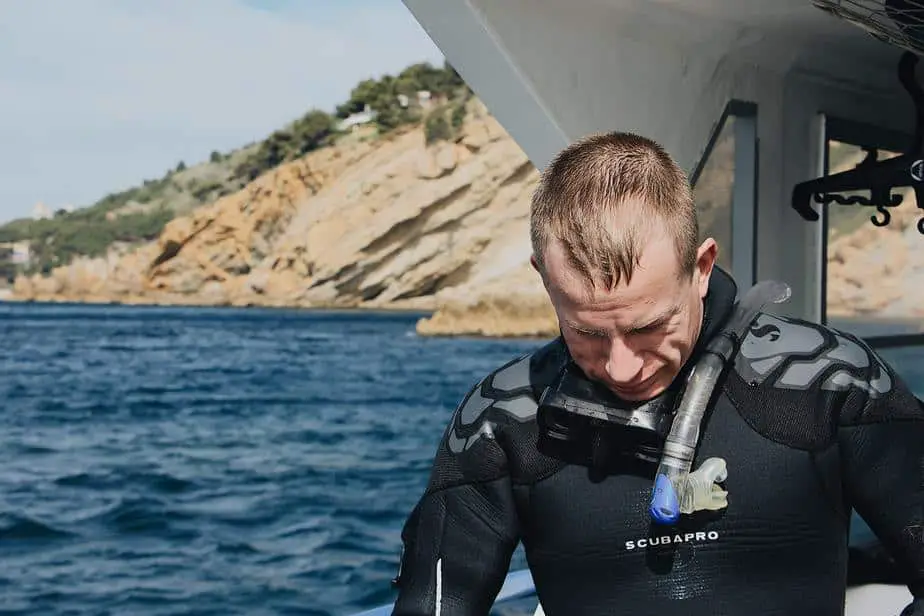If you will be engaging in multiple water sports like snorkeling, surfing, or scuba diving, then you had best purchase a wetsuit to keep yourself warm. With that said, you might be wondering if you could just use one wetsuit for all of your activities to save money. A sensible thought. Unfortunately, there are some slight differences to each wetsuit that make them optimal for their respective sports, and disadvantageous in others.
You might be wondering if there are any stark differences between a scuba wetsuit vs. a surfing wetsuit. Could you wear a surfing wetsuit for scuba diving, and vice versa? Technically the answer is yes, however it’s generally not a good idea. Surfing wetsuits are not as thick as scuba diving wetsuits because they are designed for mobility. Under the water pressure experienced at depth, they may offer little insulating capabilities. You can perhaps get away with it if you are diving in shallow, warm waters, but not in any other circumstance.
Knowing each type of wetsuit’s strengths can help you understand their limitations. Depending on how you dive and surf, you might be able to get a wetsuit that is suitable for both of those activities. Knowing when it is practical or impractical to share a wetsuit between sports is crucial, otherwise you may end up freezing. In this article, we will specifically discuss the differences between a scuba wetsuit vs. a surfing wetsuit.
Are scuba diving and surfing wetsuits the same?

We are not going to get into a wetsuit’s purpose as well as how to pick the best wetsuit; we have already written specific articles for that. Today, we are looking at the differences in scuba diving and surfing wetsuits in the context of using one of these specifically designed wetsuits in the other sport.
Each wetsuit is designed according to the requirements of their intended sport. The biggest differences between wetsuits are going to be their zipper placements, thickness of material, and stretch/flexibility. To achieve this, the wetsuits are even cut out and patterned differently. The end result is a wetsuit that excels in one area but falters in another, e.g. More flexible but less insulating, or vice versa.
Scuba diving requires one to be underwater (obviously), and thus the bodysuits ought to be stronger and thicker to remain stable under the immense water pressure and compression. Surfing requires more flexibility in order to perform the more complex and precise movements required to maintain balance on the board and ride the waves.
People who dabble in different sports could get away with using the same wetsuit for everything as long as they are sensible and not doing anything too extreme. For instance, a scuba wetsuit would probably be overkill for snorkeling, but it just means you’ll be warmer and have less flexibility. It’s not like it’s a life-endangering mistake to wear a scuba wetsuit to surf or snorkel.
Wearing the appropriate exposure suit only becomes an issue if you are diving in cold waters where insulation is key to preventing hypothermia, or if you are scuba diving at a level beyond recreational diving. If you’re still wearing a surfing wetsuit when doing a wreck dive at a depth of 30 m / 100 ft, then you are being very reckless.
Most experts recommend that if you surf or dive regularly, especially if you are doing anything advanced, you had better invest in separate suits for a safer and more comfortable experience.
Wetsuit characteristics

Wetsuits are not so drastic that each one has different characteristics. Each wetsuit has the same characteristics, just to varying degrees depending on the intended sport. For instance, you can expect all wetsuits to:
- Be a protective second layer of skin. In the context of surfing, it can help keep your skin from chafing against the board. It can also offer minor protection against superficial injuries like scratches and cuts. Very importantly, it will protect your skin from the sun’s harsh UV rays.
- Keep you warm in and out of the water. A wetsuit’s primary function is to keep you warm. This means that it fits very snug on your body. Anything else is a secondary advantage. Without a wetsuit, you won’t be able to last very long outside. Particularly for surfers; not only is the water decreasing your core temperature constantly, but you also have to account for wind chill, which is when the water amplifies wind’s cooling effects so that it’s exceptionally cold. Scuba divers also need a wetsuit that keeps them warm in deeper waters, and also one that is durable enough to withstand the pressure at depth. They do not require as much mobility as surfers, so they can get away with an extremely thick 7 mm wetsuit.
- Affect your movement in the water. As you would expect, a thicker wetsuit will restrict your movement and vice versa. Not only that, but the way the wetsuits are cut and stitched together will also affect your mobility. Surfers and swimmers require a wetsuit to be as non-restrictive as possible. Conversely, if you try to wear a scuba wetsuit to surf or swim, you will feel extremely restricted, but at least you’ll feel warmer.
Surfing wetsuit features

The biggest difference in a surfing wetsuit is that it’s designed for movement. Thus, surfing wetsuits are cut such that the legs and arms can be stretched more. Extra panels may be added in wetsuits that have thinner arms and shoulder sections.
Wetsuits are generally made from neoprene, which is a flexible and waterproof material. You can get wetsuits at varying thicknesses. If you see that a wetsuit is 3/2, that number means that it is 3mm thick in the core area and 2mm thick in the arms and legs. You’ll find that surfing wetsuits tend to be thinner than scuba wetsuits for more flexibility.
All surfing wetsuits will have their zippers at the back because surfers lay on their boards from the front, and a front zipper would dig into their body and headboard. The stitching and seams on a surfing wetsuit are also more flexible. Flatlock stitches are the superior option in this case. Fewer seams are placed around the armpit and shoulder areas for more comfort.
Having fewer seams also reduces chafing when surfing. The downside to flatlock stitches are that they aren’t the most secure, allowing water to seep into the suit as a result. Thus, many sacrifices are made in regard to heat retention when designing a more flexible and comfortable wetsuit for surfing.
Scuba diving wetsuit features

Compared to surfing wetsuits, scuba diving wetsuits are thicker – much thicker. You can get them in 3, 5, 7, and even 9 mm thicknesses. When the water gets too cold, scuba divers can even ditch the wetsuit for a drysuit for even greater insulation.
A scuba wetsuit has more of an emphasis on insulation and durability. After all, it needs to keep divers warm even when they are dozens or over a hundred feet underwater. At depth, the water pressure compresses the bubbles inside the neoprene material, making them thinner and therefore providing less insulation.
To counter this, the wetsuit material must be appropriately dense so that it can resist compression. Unfortunately, this does make the scuba wetsuit much more restrictive than a surfing wetsuit.
Even under similar water temperatures, a scuba wetsuit needs to be much thicker because it needs to provide sufficient insulation at depth, under compression, which is where it matters most. Since surfing takes place at sea level, it will never be under compression, so the bubbles inside the neoprene are not affected at all.
When selecting a scuba wetsuit, the zippers will be on the front mainly because it would interfere with the scuba tank on their back.
While scuba divers desire to have more flexibility, technically they do not require it. In order to have the longest bottom times, divers actually don’t want to move much at all to conserve energy. When they do, they just need to kick their legs with fins on to propel themselves. Scuba divers do not use their arms and ascend and descend entirely by adjusting their BCD. For these reasons, scuba diving wetsuits can sacrifice flexibility in favor of warmth.
Furthermore, scuba wetsuits are either blind stitched or flatlock stitched. They may even be glued to ensure no water leaks in from the stitches. Blind stitched and glued wetsuits are the best option to ensure heat stays trapped in the suit.
Of course, no matter what, water will get inside the wetsuit. After all, they aren’t designed to keep you dry, hence why they are “wet” suits. The goal is to regulate how much warm water is being replaced with new, cold water.
Since there is a constant flow of water going in and out of the suit, it’s also no big deal if you pee in your wetsuit. Come on, let’s be honest. When you’re out in the water, are you really going to hold it in or cut your dive/surf session short just to go pee?
People might not admit it or want to talk about it, but it’s perfectly normal since the urine will quickly get replaced anyways. Heck, you could even get away with a loud fart since the bubbles from the regulator would probably blend in with the bubbles you create. Sorry, what were we talking about again?
At what temperatures do you need to wear a wetsuit?

Regardless of whether you’re scuba diving or surfing, we think you should always wear a wetsuit, or at least a rashguard. Even if the water temperature is warm, the sun’s rays will always be a problem. Plus, having a second layer of protective “skin” can keep you safe from jellyfish stings and other minor injuries.
Plus, you will be surprised at how quickly even “warm” water will make you shiver. The sun could be sweltering hot, making you feel like you just want to spend the day in the water, but without an exposure suit, you could be at risk of hypothermia. The biggest risk is actually not the water itself, but the wind-chill factor when you get out of the water amplifying how cold it is.
In tropical destinations, where the waters are about as warm as they can get at 30°C / 80°F, you should still wear shorts and a rashguard to feel comfortable. For others, this might be enough to warrant a shorty (short wetsuit).
Depending on the individual, everybody should wear what they think is appropriate. As a general rule of thumb, it’s better to feel hot on land to begin with because your core temperature is only going to decrease over time once you’re in the water. It might even be a good idea to wear a rashguard underneath the wetsuit for extra insulation.
For your reference, below is a table that should give you an idea of what exposure suit to wear under what temperature ranges:
| Water Temperature Range | Wetsuit Thickness | Recommended Wetsuit Type | Seal Type |
| >72°F (>22°C) | N/A | Rash guard | N/A |
| 65°- 75°F (18° – 24°C) | 0.5 mm – 2/1 mm | Top / Shorty | N/A |
| 62°- 68°F (16° – 20°C) | 2 mm – 3/2 mm | Springsuit / Full Suit | Flatlock |
| 58°- 63°F (14° – 17°C) | 3/2 mm – 4/3 mm | Full Suit + Boots | Sealed |
| 52°- 58°F (11° – 14°C) | 4/3 mm – 5/4/3 mm | Full Suit + Boots + Gloves + Hood | Sealed and Taped |
| 43°- 52°F (6° – 11°C) | 5/4 mm – 5/4/3 mm | Full Suit + Boots + Gloves + Hood | Sealed and Taped |
| 42°F (6°C) and below | 6/5 mm + | Full Suit + Boots + Gloves + Hood | Sealed and Taped |
Parting words
So, can a scuba wetsuit be used for surfing and vice versa?
A surfing wetsuit is not recommended for use with scuba diving unless you are in very shallow depths and in very warm waters. The stretchy material used in a surfing wetsuit, plus its general thinness and flexibility will make it hard for you to stay warm. Scuba diving derives very little benefit from being more flexible since most of the movement is controlled by the BCD and fins anyways.
On top of that, a surfing wetsuit would be subjected to water pressure that it’s not designed for. It’s a very real possibility that when you surface, the surfing wetsuit will have turned flat or lost its shape due to the compression at depth. It would not be useful for surfing or scuba diving any more. This is assuming that you haven’t already ended the dive already due to the cold.
As for using a scuba wetsuit to surf, it would also be very uncomfortable. The scuba wetsuit, being much thicker, will restrict your movement. In order to surf comfortably, you need to have much more flexibility in your arms and legs which a scuba wetsuit would not let you do. There is also the issue of zipper placement which can be annoying.
Overall, even if it is technically possible to get away with using a scuba wetsuit to surf or a surfing wetsuit to scuba, it’s just not worth the hassle. If you plan on frequently surfing or scuba diving, then it is best to invest the money to get separate suits. If you will infrequently scuba/surf, then rent the appropriate wetsuit for those few occasions that you do. You will feel more comfortable and enjoy both sports the way they are intended to be enjoyed.


